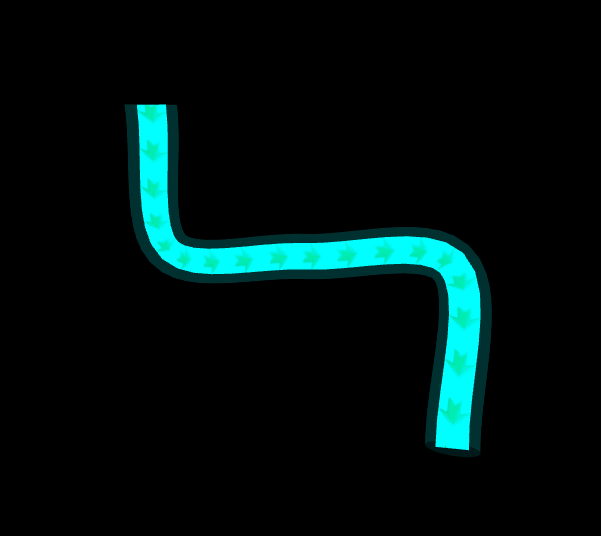ThreeJS 的效果样例流水管线(五)
一、流水管线

实现逻辑:
1)先自定义几个点,通过CatmullRomCurve3生成一条平滑曲线
2)根据生成的曲线在XY面扩展一个面,其中需要注意顶点索引、UV坐标添加的顺序,否则可能会导致绘制的图片混乱,不是完整的图片
3)添加纹理同时设置偏移量实现流动效果
4)为了保证显示的箭头图标不失真,根据管线的长度和图标的长度动态计算repeat的个数


function addFlowByGeometry() { // 自定义点 const points = [ new THREE.Vector3(-5, 5, 0), new THREE.Vector3(-5, 0, 0), new THREE.Vector3(0, 0, 0), new THREE.Vector3(5, 0, 0), new THREE.Vector3(5, -5, 3), ]; // 生成一条平滑的曲线 const curve = new THREE.CatmullRomCurve3(points); const srcGeometry = new THREE.TubeGeometry(curve, 64, 0.8, 32, false); const srcMaterial = new THREE.MeshBasicMaterial({ color: 0x00ffff, transparent: true, opacity: 0.1, side: THREE.DoubleSide // 两面都显示 }); const srcMesh = new THREE.Mesh(srcGeometry, srcMaterial); scene.add(srcMesh); // 定义曲面的分辨率 const widthSegments = 32; const heightSegments = 32; // 定义顶点位置和纹理坐标 const vertices = []; const uvs = []; // 定义扩展宽度 const width = 0.5; for (let y = 0; y <= heightSegments; y++) { for (let x = 0; x <= widthSegments; x++) { const u = x / widthSegments; const v = y / heightSegments; // 获取曲线上的点 const point = curve.getPoint(u); // 获取曲线的切线向量 const tangent = curve.getTangent(u); // 计算法线向量 const normal = new THREE.Vector3(-tangent.y, tangent.x, 0).normalize(); // 扩展成平面 const px = point.x + normal.x * (v * 2 - 1) * width; const py = point.y + normal.y * (v * 2 - 1) * width; const pz = point.z; vertices.push(px, py, pz); uvs.push(u, v); } } // 定义顶点索引 const indices = []; for (let y = 0; y < heightSegments; y++) { for (let x = 0; x < widthSegments; x++) { const a = x + y * (widthSegments + 1); const b = x + 1 + y * (widthSegments + 1); const c = x + 1 + (y + 1) * (widthSegments + 1); const d = x + (y + 1) * (widthSegments + 1); indices.push(a, b, d); indices.push(b, c, d); } } // 创建一个自定义的 BufferGeometry const geometry = new THREE.BufferGeometry(); // 将顶点位置添加到几何体 geometry.setAttribute('position', new THREE.BufferAttribute(new Float32Array(vertices), 3)); // 将顶点索引添加到几何体 geometry.setIndex(new THREE.BufferAttribute(new Uint16Array(indices), 1)); // 将纹理坐标添加到几何体 geometry.setAttribute('uv', new THREE.BufferAttribute(new Float32Array(uvs), 2)); // 创建纹理加载器 const textureLoader = new THREE.TextureLoader(); // 加载纹理 const texture = textureLoader.load('Objects/imgs/arrow.png', () => { texture.wrapS = THREE.RepeatWrapping; texture.wrapT = THREE.RepeatWrapping; const originalWidth = texture.image.width; const originalHeight = texture.image.height; // 创建平面几何体 const [allWidth, allHeight] = [curve.getLength(), 1]; // 更新几何体的尺寸 texture.repeat.set(allWidth / (originalWidth * allHeight / 2 / originalHeight), 1); // 创建材质 const material = new THREE.MeshBasicMaterial({ map: texture, side: THREE.DoubleSide, color: 0x00ffff, wireframe: false }); // 创建网格 const mesh = new THREE.Mesh(geometry, material); // 将网格添加到场景中 scene.add(mesh); }); setInterval(() => { texture.offset.x -= 0.04; }, 30) }